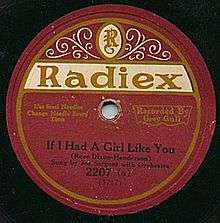Radiex Records

Radiex Records was a United States record label of the 1920s. It was manufactured by Grey Gull Records of Boston, Massachusetts, from 1921 until the demise of Grey Gull in late 1930; it was then pressed for a few more months into 1931 by the successor firm which continued the Radiex, Van Dyke and Madison labels. Radiex records were sold in Montgomery Ward catalogs although they were not manufactured specifically for that firm. In some cases, records have been found which had the labels of other Grey Gull products over Radiex labels...or vice versa.
Radiex Records were standard lateral-cut double sided 78 rpm disc records pressed in various colours of shellac which generally stood up to wear poorly. The earliest paper sleeves in which Radiex records were sold described them as "The Record of Beauty." The issues are popular vocal and dance numbers of the era, from masters recorded by Grey Gull, Plaza Music, Emerson Records, and sometimes Paramount Records. Radiex discs bore the same catalog numbers, and contained the same material, as Grey Gull and other products of that company. There are however examples of Radiex issues using other takes of the same tunes as the corresponding Grey Gull issues (for example Sweethearts On Parade on Radiex 1587, which uses a faster take -A with partly different solos than on the slower take -B used on Grey Gull 1587).
Radiex Records were numbered in a 1000 series (dance music), a 2000 series (vocal), a 4000 series (standards) and a seldom-found 7000 race series, along with a mysterious 8000/8100 series whose function is not currently known.
When the Grey Gull firm ceased business in late 1930, a successor firm continued pressing Radiex, Van Dyke and Madison records until some point in the spring of 1931. These records carried Madison numbers (5000s followed by 6000s) and also had an 800/900 series which paired older Grey Gull "B" sides; a few country records have been seen with 51xx numbers. These records are visibly slightly different from the earlier Boston-pressed Grey Gull products.
Noted record collector and reissue specialist David Lennick, of Toronto, Ontario, has revived the use of the Radiex name on CDs.
The Radiex label was discontinued (on 78 r.p.m. discs)in 1931. A fairly large number of label designs and colour variations were used on Radiex records over its short lifespan. Little is known about the source of the "Radiex" name, which may have been used to suggest some connection with radio.